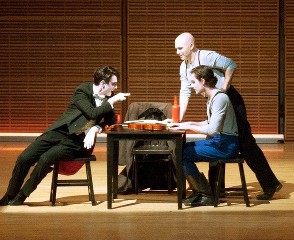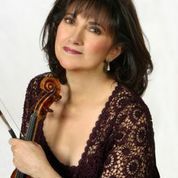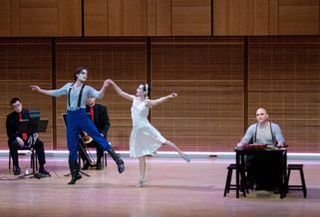|
Back
Yale’s “Cirque du soldat” New York
Zankel Hall, Carnegie Hall
04/06/2014 -
Igor Stravinsky: L’Histoire du soldat
Michael Cerveris (The Reader), Tom Pecinka (The Soldier), James Cusati-Moyer (The Devil), Mariko Parker (The Princess)
Ani Kavafian (Violin), Samuel Suggs (Double bass), David Shifrin (Clarinet, Music Director), Michael Zuber (Bassoon), Mikio Sasaki (Trumpet), Stephen Ivany (Trombone), Georgi Videnov (Percussion)
Elizabeth Diamond (Stage Director, Translator), Emily Coates (Choreographer), Michael Yeargan (Scenic Designer), Ilona Somogi (Costume Designer), Solomon Weisbard (Lighting Designer)
Presented by Yale School of Music, Yale School of Drama, Yale in New York

J. Cusati-Moyer, M. Cerveris, T. Pecinka (© Dana Astmann)
Rising from the mire and mustard-gas of the War To End All Wars came a sad parade of parables, the parables of the dung-covered enlisted soldier. No more “do or die for God and country”. Now it was The Good Soldier Schweik, Kodály’s charlatan hero Háry János, Alban Berg’s miserable Wozzeck and the savage comedy which comes closest to Berg’s masterpiece, Igor Stravinsky’s L’Histoire du soldat.
Tsar, Sultan, and Emperor were suddenly extinct, and with them the fable that war was a glorious tribute to loyalty and courage. Unlike Berg, Stravinsky didn’t need an 18th Century play to make his point. The Hungarian surrealistic poet, C. P. Ramuz started with Joe Everyman Soldier, too tired to challenge the nifty devil. For, like all the soldiers of these World War I tales, he had been sucked into the military maelstrom. When he looked into the sky, it wasn’t to see God. He was looking up to see what Guillaume Apollinaire wrote: “Rain...raining dead eyes.”
C. F. Ramuz based his wartime fable on an old Russian tale, where the Devil meets the soldier, and they gamble on damnation and victory. The story was far more complicated than that, and Stravinsky’s pared down orchestra (for economic reasons) turned it into an original form, a combination of narration, song, speech (actually a kind of sprechstimme), with ballet, with old-fashioned comedy, with...
Well, with challenges for everybody involved.
And when the professional and student forces took up the challenge, first in New Haven and last night in New York, the event was less an original “happening” that an artistic whole.
This was a new translation by Elizabeth Diamond, with the folky idioms on the delights of money and the Stock Market well attuned to the original French. In fact, the Ramuz libretto still is fresh, zesty, it still tingles with our own Gordon Gecko adage that “Greed is good.”
Ms. Diamond’s stage gave the illusion of simplicity. The Reader (narrated by that most eclectic actor, Michael Cerveris), was on one side, the band at the other. In between, our Soldier and Devil danced, fought with glee and Satanic passion.
How did they do it? Had Charles Chaplin been either the lanky soldier Tom Pecinka or devil James Cusati-Moyer, he would have had the same movements. Yes, they were exaggerated (this is partly farce), but they were fervent (we are speaking of life and death). The two, both in whiteface, both with different costumes, bounced back and forth. The devil whisked over the stage. The soldier stood at attention, they changed places, chased each other. They danced and argued and played games.
Mr. Cusati-Moyer was satanic in black and white–and totally camp as the old woman in drag. When it was his time to die, it wasn’t death, he somehow managed to have the air pumped out of him, deflated like a Macy’s parade balloon. But their unceasing energy, the resonant drama of Mr. Cerveris and, above all, that crazy 1920’s music (written in 1918), but a Stravinsky who relished circuses, ballet, jazz and old chorales with equal enthusiasm, gave it a flying unity.

A. Kavafian (© Yale School of Music)
Nobody ever quite assembled such an interesting orchestra as Stravinsky here. Violin and double bass, trombone and percussion. With rhythms and themes of jazz and tangos and waltzes and of course the march of the poor soldier Joe. Sitting on the side of the stage dressed in devilish black and red, they were each brilliant soloists, led by clarinetist David Shifrin. Of course the major player was the violinist here, Ani Kavafian, who mimed along with the soldier–but who played on those open strings with demonic glee.
The brilliance of the music was not always as successful as the staging. The Soldier’s Tale can succeed at its best when played with a whimsical touch. Not ironic, not sarcastic. The music is serious (and was here seriously played). But the texture came down with a heavy beat. It didn’t detract from the staging, but that lightness would keep us up in the air instead of...well, glued to our seats.

T. Pecinka, M. Parker (© Dana Astmann)
Toward the end came one of the most evocative scenes. Whereas Devil and Soldier played with body and face and makeup and costumes, the dances–tango, waltz, ragtime–were played with grace and innovation by Mr. Pecinka and Mariko Parker. Nobody wanted to break the spell of the evening by applause, but so delicious was the choreography here that applause was inevitable.
And true enough, the dance was an entr’acte for the two-man never-ending show. What a shame that it was only displayed here one time. Yes, Zankel Hall was filled last evening, but this Soldier’s Tale could be seen by a far more eclectic audience than your usual New Haven solons and the New York crowd. Children might not understand it, but they would love the exaggeration, while musicians of every stripe could relish the band.
Still, how lucky we were to witness it even once. Hopefully a YouTube will be on of this production, for it deserves the lasting impact of the composer’s own immortal Cirque du soldat.
Harry Rolnick
|